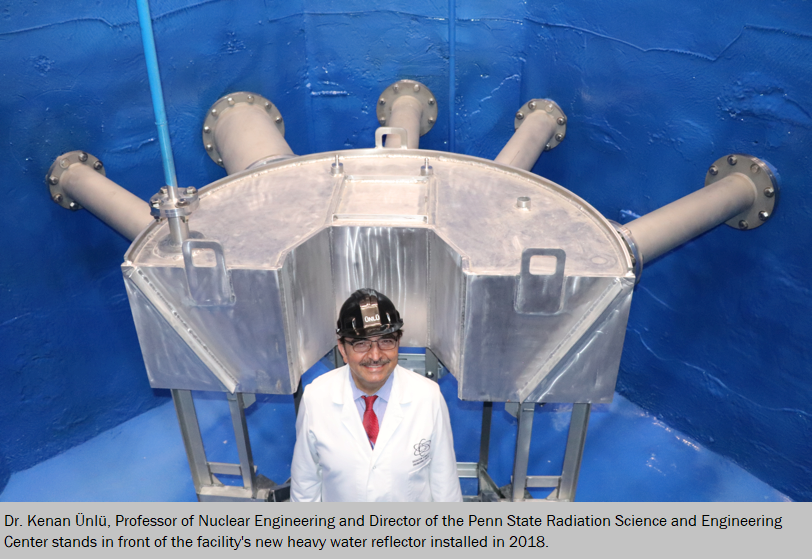Message from the Director
Welcome to the Radiation Science and Engineering Center (RSEC), home of the Penn State Breazeale Reactor (PSBR). The RSEC promotes research, education, and application of radiation and nuclear science and engineering to students, faculty, and staff at Penn State, as well as to scientists in other universities, governments, and industries worldwide. The RSEC is a unit under the Vice President for Research and the Dean of the College of Engineering at Penn State University.
The PSBR is the longest continuously operating licensed research reactor in the United States. As we celebrate 70 years of operation, with a rich history and countless achievements in research, teaching, and service activities, I would like to highlight some of our accomplishments over the last ten years.
- The new Reactor Core Moderator Assembly and new Beam Ports installation were completed in the Summer of 2018. This development leads to new opportunities for the installation of state-of-the-art neutron beam techniques at the RSEC. We now have five new neutron beam ports and seven neutron beam lines. (See: Penn State Breazeale Reactor achieves first simultaneous neutron beam operations | Penn State University)

- The RSEC continued with all essential research projects with faculty, graduate students, and outside entities during the COVID-19 pandemic period. Dedicated RSEC staff provided neutron and gamma irradiation, performed reactor maintenance and checks, fuel loadings, and all other required NRC related inspection activities. (See: Operation Nittany Lion increased deployment readiness during COVID | Article | The United States Army)
- One of the new techniques that is installed at the RSEC is Small Angle Neutron Scattering. Due to closure of the HZB-Berlin research reactor in Germany, their SANS facility ($9.8 million value) was available. After several trips to Berlin and providing a letter of interest from Penn State, the HZB administration decided to donate the SANS facility instrument to Penn State. All components of the HZB SANS was transported to Penn State in February 2024 and installation of the components has recently been completed. The Penn State SANS will be tested and completely operational by the end of 2025.(See: New device positions Penn State at the forefront of university research reactors | Penn State University)
- A mesitylene based third generation cold neutron source was designed, built, installed, and tested in 2024.
- A new supermirror neutron guide system, for both in-pile and out-of-pile sections of the SANS beamline, as well as one of the other cold neutron beam lines was designed, constructed, and installed.
- To fit the Penn State SANS and other neutron beam techniques, a new Beam Hall needed to be constructed. After over 12 years of planning and several ups and downs, the RSEC expansion project was approved and funded by the College of Engineering ($9 Million) and RSEC ($1 million). DOE-NEUP has contributed $360K for a new waste storage tank installation in the newly expanded space. About 12,000 sq. ft. of new area was added to RSEC. The new Beam Hall has about 6,000 sq. ft. of area to accommodate state-of-the-art neutron beam facilities including the SANS. The first floor of the expansion (~6,000 sq. ft.) has offices for nuclear engineering faculty, RSEC staff, graduate students and visiting scientists. The construction of the RSEC expansion was completed in July 2022. (See: Nuclear science, engineering spark collaborations across Penn State and beyond | Penn State University)
- A new Neutron Imaging Facility (NIF) with neutron radiography and tomography capabilities was installed and verified as an ASTM Category I facility. We performed neutron imaging of a piece of aluminum believed to be part of Amelia Earhart’s airplane. Our initial results prompted widespread interest from media outlets from all over the world. Another project completed with NIF was the visualization of microplastics in environmental samples.(See: Investigating Amelia Earhart's disappearance mystery with neutrons | Penn State Engineering)
- A new Co-60 source for our pool gamma irradiator was received and installed. The project was funded by DOE-NEUP ($250K). Gamma irradiation activity related projects increased dramatically.
- New reactor digital control system (DCS) equipment was received and installed. The project was funded by ~$1M in DOE-NEUP infrastructure funds, $250K in RSEC funds, and a $290K equipment donation from Schneider Electric.
- RSEC joined the DOE-INL Nuclear Science User Facilities (NSUF) group as a partner institution in 2023.(See: Penn State joins DOE Nuclear Science User Facilities program | Penn State Engineering)
- In September 2023, Penn State received the nation’s first TRIGA nuclear fuel delivery in over a decade.(See: Penn State receives nation’s first TRIGA nuclear fuel delivery in a decade | Penn State University)
- The RSEC serves as the cornerstone of the nuclear engineering teaching community at Penn State. A majority of the nuclear engineering laboratory classes and several special topic classes are taught at the RSEC.
- The RSEC is the home of the new graduate Nuclear Security Education Program. Educating the next generation of technical experts in nuclear security practices is a critical element in order to ensure the successful long-term operational security of nuclear and radiological materials worldwide.(See: Penn State College of Engineering introduces graduate nuclear security option | Penn State University)
- We have spearheaded or collaborated with a wide range of research projects in the last decade, most of which are interdisciplinary in nature. They involve faculty members, students, and scientists from within the Penn State College of Engineering, other Penn State colleges, U. S. and international universities, U. S. national laboratories, and industry.
- The PSBR is a primary neutron source for radiation services, research, and development for many industrial and government entities. Over 20 organizations use our services each year.
- The RSEC is strongly engaged in outreach activities with the public. Over 3,000 people visit the facility each year. Tour groups range in size from a single visitor to over one hundred people. Tours are carefully matched to the audience, which include primary school students, scouting groups, high school students and teachers, college students, visiting faculty, and government officials.
The above are only some of the activities at the RSEC over the last ten years, despite the COVID-19 pandemic restrictions. We are very excited about new developments at the RSEC and thankful to everyone involved; especially the dedicated RSEC staff. It is an exciting time for neutron science at PSU, especially with the installation of SANS. This effort will open new horizons for neutron science at Penn State in addition to traditional nuclear methods. The Penn State Breazeale Reactor is the only university research reactor facility that has SANS capability in the USA.
The Penn State RSEC will continue its mission of safely providing neutron and gamma-ray sources and nuclear techniques for research, education, and service into the future.
For more information about the history and latest projects at RSEC, please see the 70th Anniversary booklet by clicking the 70th logo on the right. Or for the latest news, see the News & Update page.




